Of all the spaces in a home, the outdoor deck holds a special kind of magic. It’s not just a structure of wood or composite; it’s a bridge between your indoor life and the open sky. When I walk onto a truly great deck, I feel it—it’s like stepping into the heart of a home’s soul, a place where the vibrant terracotta tiles feel warm underfoot, echoing the sun-baked courtyards of my travels through Oaxaca and Peru.
This is where the real beauty happens, when we stop thinking about just building a deck and start dreaming of creating an outdoor room with its own story. It’s about more than adding square footage. It’s about honoring the traditions of craft, community, and living beautifully. Build a space for overflowing family dinners, for quiet morning coffees with light filtering through the leaves, for celebrating life’s simple moments. These aren’t just deck ideas; they are invitations to weave the warmth, color, and artisanal spirit of Latin America into the fabric of your own home.
So, let’s walk through this together. We’ll explore how to build a space that’s not just functional, but deeply, truly yours—a place that tells your story and feels like coming home.
1. Start with Intention: What is the Soul of Your Deck?
Before a single board is cut, I always ask my clients to close their eyes and imagine a perfect day. What are you doing out there? Who is with you? The foundation of a meaningful outdoor space begins with its soul, its purpose. It’s the very same way a master potter first imagines the vessel’s use—Is it for pouring water? Holding flowers?—before their hands ever touch the clay. Without this clarity, it’s so easy to build something beautiful that, honestly, you never use.
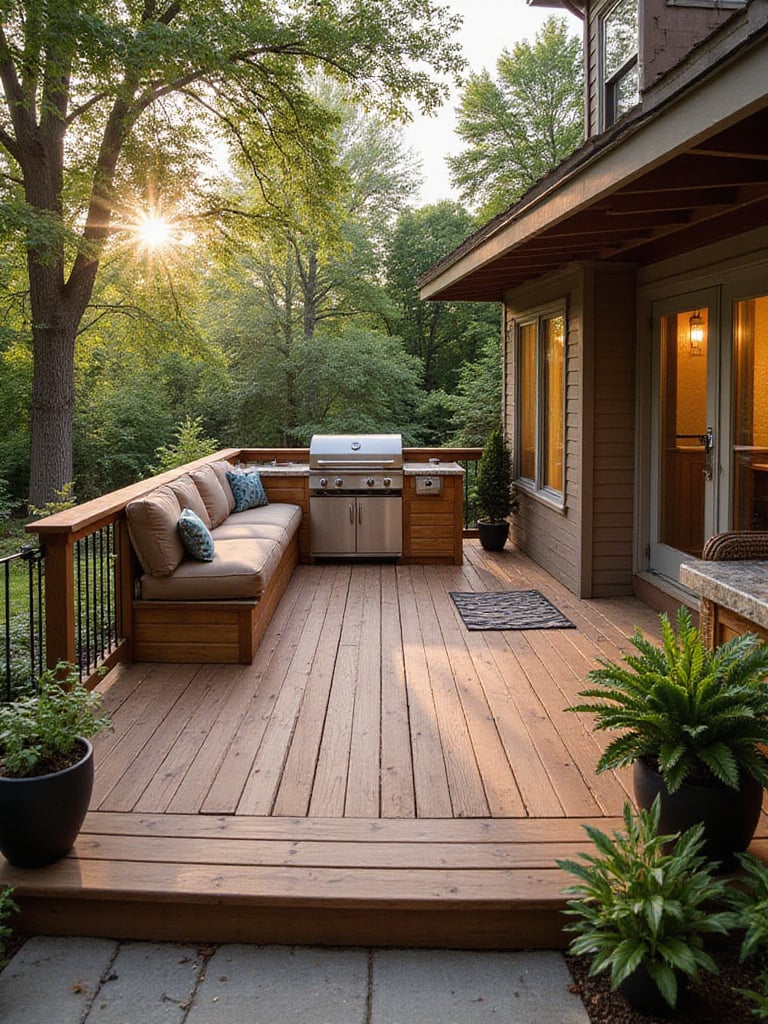
I once worked with a family who was convinced they needed a massive, sprawling deck for entertaining. But as we talked, I learned their most cherished ritual was a quiet Sunday morning with coffee and books. We ended up designing a much cozier main deck with a tiny, sun-drenched nook off the main bedroom, just big enough for two chairs. That little nook became the most-loved spot in their entire home. It’s about designing for the life you actually live, not the one you think you should have. Knowing your deck’s purpose guides every choice, from the tiles you choose to the way the afternoon light will fall across a handwoven hammock.
When every element has a reason for being, the space just works. It feels right. And that’s the kind of intentional design that makes a house a home.
Now, with that intention in mind, let’s look at the very ground beneath your feet. What if your yard isn’t perfectly flat?
2. Embrace the Land: Creating Poetry with Multi-Level Decks
A sloped yard isn’t a problem; I truly believe it’s an opportunity for poetry. Multi-level decks can transform a challenging hill into a cascading series of outdoor rooms, flowing down the landscape much like the agricultural terraces you see in the Andes. This approach does more than just add function—it adds incredible visual drama and creates distinct zones that feel both separate and connected.
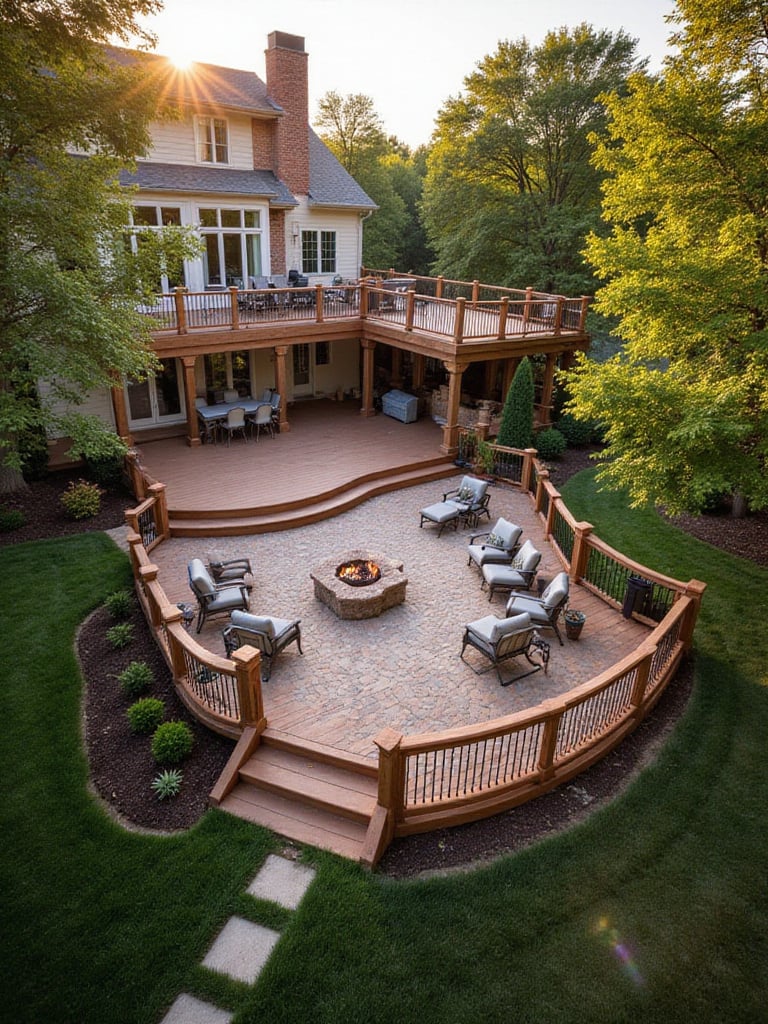
What’s so brilliant about this is how you work with the land, not against it. You can carve out different experiences at each level. Imagine an upper level for dining, right off the kitchen, where you can pass dishes through a window. A few steps down could lead to a conversational lounge, nestled in privacy. And a final, lower level might be home to a fire pit, feeling intimate and tucked into the garden. These transitions—the stairs—become a place for their own artistry. I love lining stair risers with vibrant, hand-painted Talavera tiles. Each step becomes a little jewel, a pop of color that guides you from one space to the next.
This is how you turn a simple platform into a journey. You create an experience.
Of course, the foundation of this journey is the material itself. And this is where it gets tricky, balancing tradition with modern life.
3. Choose a Durable Canvas: The Case for High-Quality Composite
Okay, I know. As someone who lives and breathes natural materials, suggesting composite decking might sound like a surprise. And believe me, the feel of real aged wood underfoot is something special. But here’s the thing: I’ve also seen beautiful Ipe wood turn grey and splintered because the yearly maintenance became too much of a chore. A deck should be for relaxing, not for adding a major task to your to-do list every spring.

Think of modern, high-quality composite decking as the perfect, neutral canvas. It gives you a clean, durable foundation that allows the real stars of the show—your artisanal tiles, vibrant textiles, and handcrafted furniture—to truly shine. The new composites have come so far; many have a subtle, wood-grain texture that feels great and stands up to intense sun and summer storms without fading or warping. This practical choice frees up your time and energy to focus on what brings the soul: tending your herb garden, polishing copper accents, or simply enjoying the space.
It’s about being smart, so you can spend less time maintaining and more time living.
And with that solid foundation, you can begin to design the flow of that life.
4. Designing Your Courtyard: Carving Out Zones for Living
In Latin America, the patio or courtyard is the center of the home. It’s not just one big open space; it’s a collection of smaller spaces for different parts of life. We can bring that same idea to our decks. By creating dedicated zones for cooking, dining, and relaxing, you give the space an intuitive flow that encourages people to move, gather, and connect.
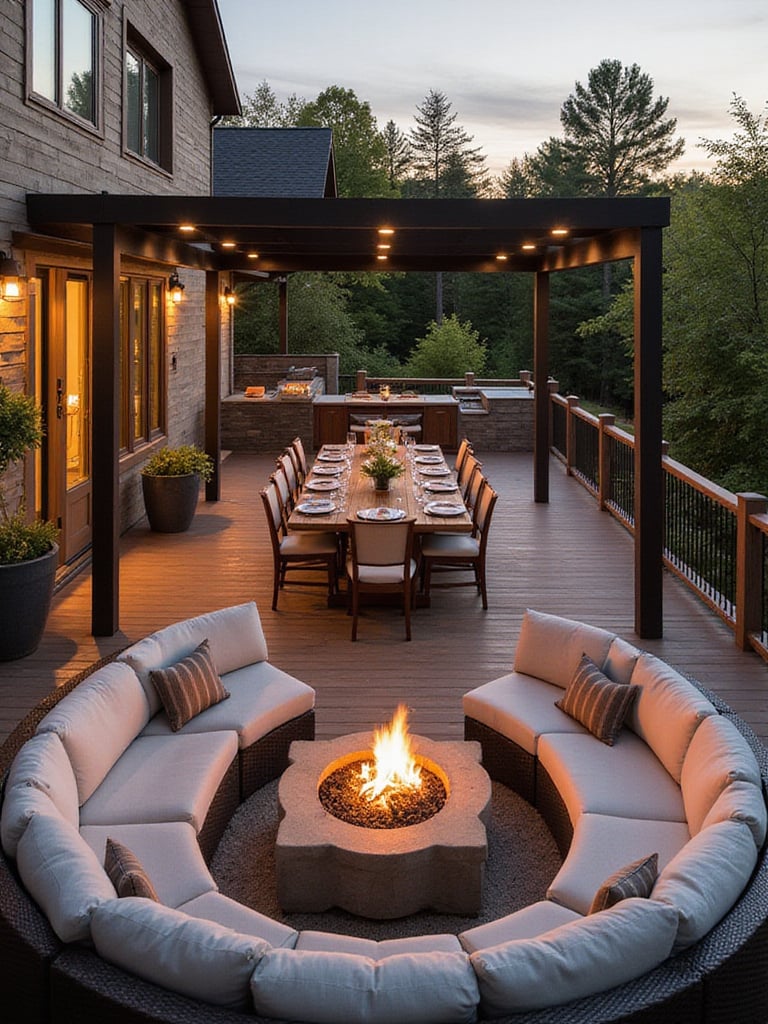
The trick is to define these zones with subtle, beautiful cues instead of hard walls. Maybe the cooking zone, near the kitchen door, is anchored by a collection of terracotta planters brimming with cilantro, mint, and basil. The flooring could shift from composite boards to a beautiful inset of patterned cement tile to signal the dining area, creating a “rug” effect that anchors the table. And the relaxation zone? You can define it with a large outdoor rug and an L-shaped sectional that invites long, lazy conversations. You’re creating rooms without walls.
Each zone has its own energy, but they all speak to each other through a shared palette of colors and materials, feeling both organized and incredibly welcoming.
Now, how do we make these zones comfortable on a hot, sunny afternoon?
5. A Place in the Shade: Pergolas, Vines, and Staying Cool
In warmer climates, shade isn’t a luxury; it’s a necessity. But it’s also a fantastic opportunity for architectural beauty. A simple shade structure can transform your deck from a place you only use in the morning to a welcoming retreat all day long. A pergola, built from warm cedar, instantly adds a sense of verticality and enclosure, making the space feel more like a room.
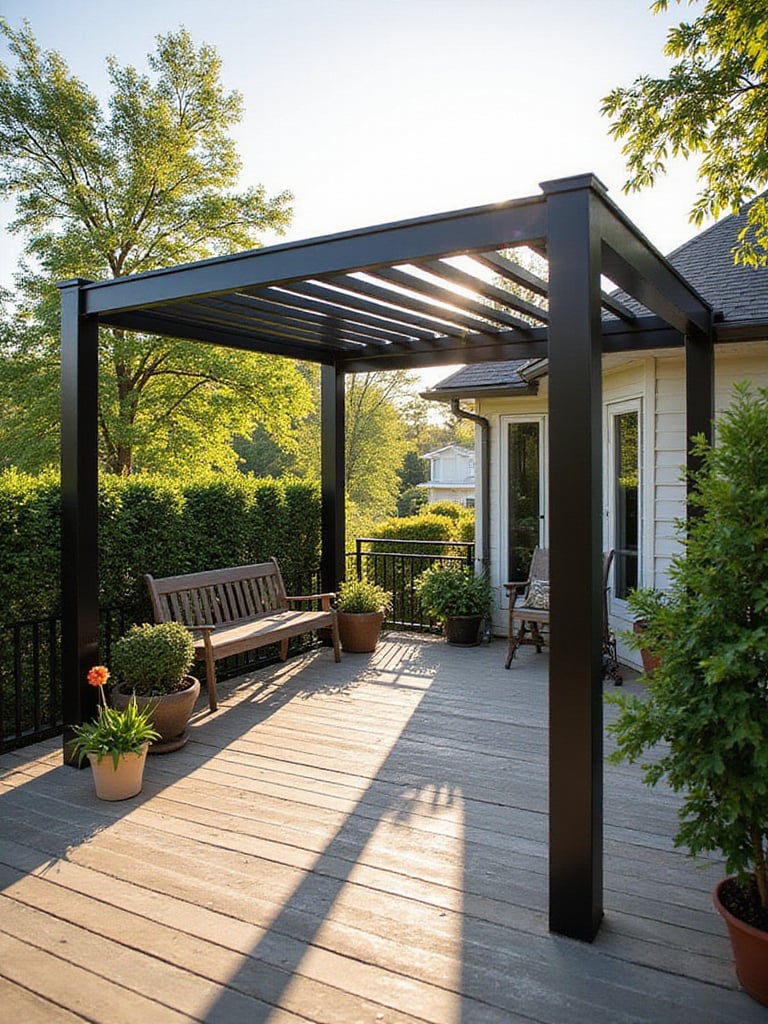
What really gets me is when that structure becomes a living thing. I love draping a pergola with climbing bougainvillea or sweet-smelling jasmine. It becomes living architecture that changes with the seasons, its flowers adding color and fragrance, and the shifting patterns of its leaves casting the most beautiful, dappled light onto the floor below. You can also use modern shade sails in earthy tones like ochre or terracotta, their angular shapes adding a contemporary touch while providing flexible, targeted shade.
Shade does more than just cool you down. It creates atmosphere and comfort, beckoning you outside even in the heat of the day.
And as you create these comfortable nooks, you might start thinking about a bit of privacy from the neighbors.
6. Creating Intimate Spaces with Living Walls and Artisan Screens
Privacy doesn’t have to mean a big, boring fence. In fact, it’s one of my favorite places to inject artistry and life into a Deck Design. Think of your privacy solutions as vertical canvases. A living wall, planted with lush ferns or even a vertical garden of strawberries, offers a soft, natural screen that also cools the air around it. It’s a beautiful way to create a sense of enclosure without feeling boxed in.
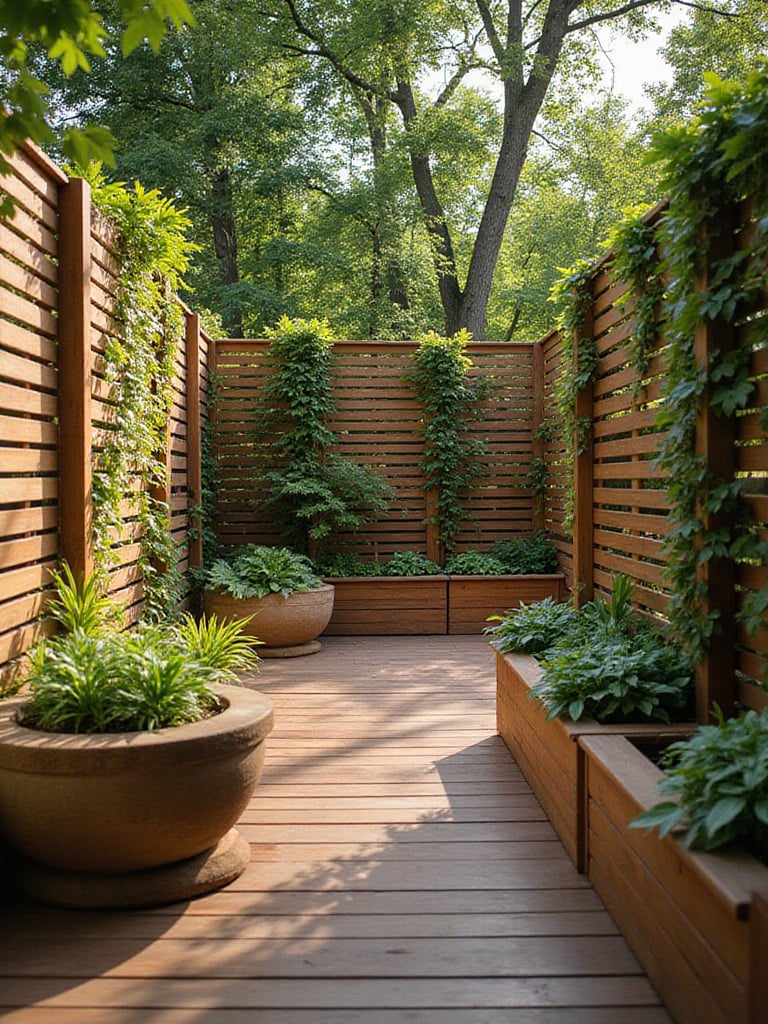
Another approach I adore is using decorative screens. Imagine a laser-cut metal or wooden screen with patterns inspired by traditional celosía (lattice-work). They don’t just block the view; they filter it, casting intricate shadows that dance across the deck throughout the day. You can even design custom panels that incorporate motifs that are meaningful to your family. These solutions create layers of visual interest, giving you intimate nooks for quiet conversation while still feeling connected to the rest of the garden.
It’s about creating seclusion that feels beautiful and intentional, not isolated.
As dusk begins to fall, that beauty takes on a whole new dimension with the right light.
7. Bringing the Deck to Life After Dark
A deck without good lighting can feel a bit empty and intimidating after sunset. But with a thoughtful, layered approach, it can become the most magical place in your home. The goal is to create atmosphere, not to flood the space with a single, harsh light. Think in layers: the warm, overall glow, the specific light for tasks, and the little highlights that add drama.

Start with the ambient glow. Strings of Edison bulbs woven through a pergola or crisscrossing the deck instantly create a festive, celebratory feel reminiscent of a neighborhood festival. Then, add task lighting where you need it—a focused downlight over the grill, or soft, low-voltage lights built into the stair risers for safety. Finally, the accent lights. This is the fun part! A small, hidden uplight can turn a potted agave into a dramatic sculpture at night. A soft spotlight can graze a stone wall, bringing out its texture.
When you mix these sources—the overhead glow, the mid-level lanterns, the low-level path lights—you create a rich, three-dimensional scene that’s both functional and enchanting. It’s an invitation to linger long after the sun goes down.
And to keep that enchanting space tidy, you’ll need some clever places to hide the essentials.
8. Clever Craftsmanship: Beautiful Built-in Storage
Nothing kills the vibe of a beautiful deck faster than a big plastic storage bin. That’s why I always try to weave storage directly into the design, turning a practical need into an opportunity for craftsmanship. Custom-built benches are the perfect solution. A long bench with a hinged lid not only provides ample seating but also a weather-protected home for cushions, outdoor games, and blankets for chilly nights.
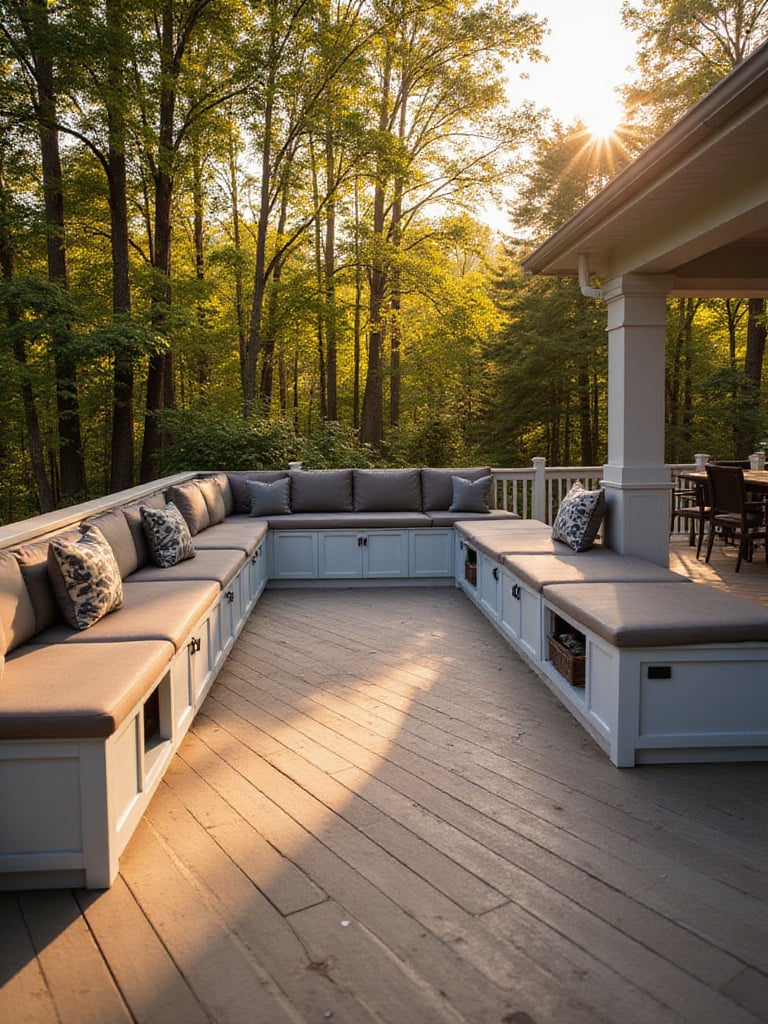
Think of these pieces as beautifully crafted furniture. The front of a storage bench could feature carved panels with a traditional motif or be accented with the same colorful tiles used elsewhere on the deck. A low retaining wall at the edge of the patio can be designed with hidden compartments inside. The idea is to make storage disappear into the architecture itself, so it serves its purpose without adding clutter.
It’s about honoring that age-old principle of making things that are both useful and beautiful.
And what could be more useful—and beautiful—than your own private wellness retreat?
9. Your Private Cenote: Creating a Wellness Retreat
There’s something deeply restorative about sinking into warm water under the open sky. But just plopping a hot tub on the corner of the deck rarely feels right. To make it a true retreat, we need to integrate it thoughtfully, creating a sanctuary that draws on the Latin American love for natural bathing spots and communal wellness. The goal is to make it feel like you’ve discovered your own private cenote.
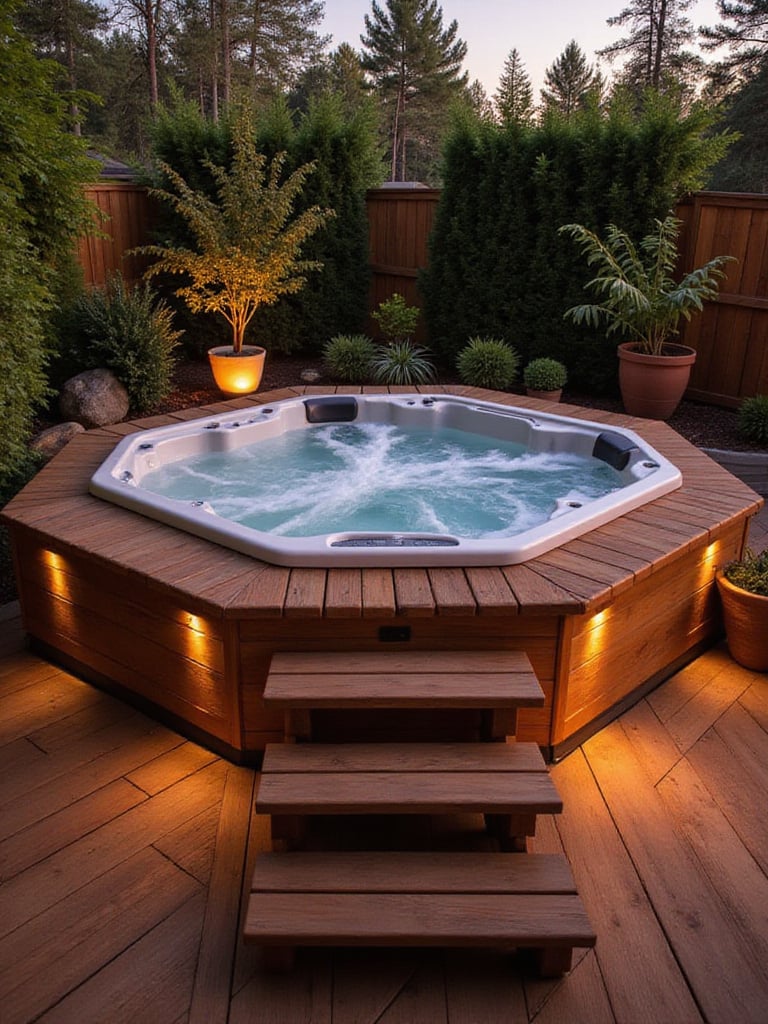
Instead of leaving the hot tub exposed, consider sinking it so it’s flush with the deck surface. Surround it with materials that feel good to the touch, like smooth, warm stone or rich wood. Then, create privacy with lush, tropical plantings—think broad-leafed plants that create a sense of enclosure and maybe some aromatic rosemary or lavender nearby. A small, trickling water feature can mask neighborhood noise and add to the serene atmosphere.
This turns a simple appliance into an experience—a space dedicated to relaxation, connection, and wellbeing.
From a quiet retreat for two to a gathering for many, let’s talk about another elemental draw.
10. The Hearth of the Patio: Gathering Around the Fire
Fire is elemental. It’s magnetic. For centuries, humans have gathered around the flame for warmth, for food, for stories. A fire feature on your deck becomes its heart—el fogón—a natural focal point that pulls people together and instantly creates a cozy, communal atmosphere. Whether it’s a modern gas fire pit or a grand wood-burning fireplace, it extends the life of your deck into the cooler months and adds undeniable drama.
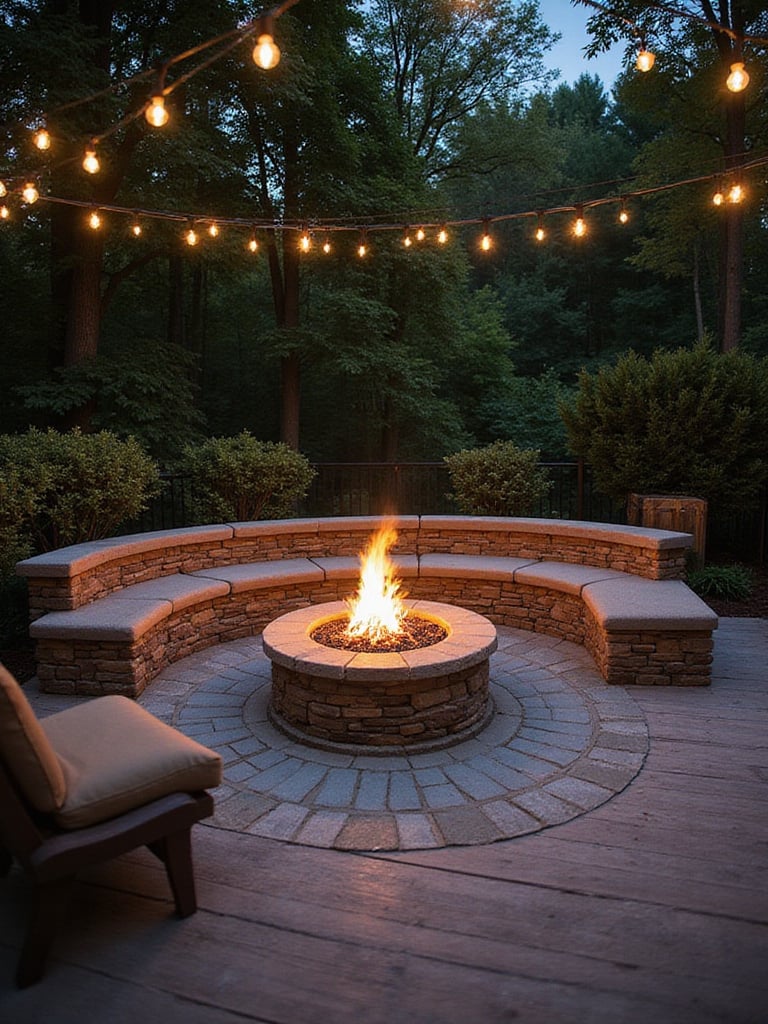
When designing the fire area, think in a circle. Arrange seating around it to encourage face-to-face conversation. A built-in, curved stone bench topped with vibrant, weather-resistant cushions is both practical and beautiful. You can use materials like stucco, cantera stone, or hammered copper to tie the fire feature into a Latin American aesthetic. A few things to keep in mind:
- Safety first, always. Make sure you have proper clearance from any structures and check local regulations.
- Fuel for thought. Wood-burning offers that incredible crackle and smell, but gas is all about convenience. Choose what fits your lifestyle.
- Tuck away the tools. Design a clever nook for firewood or hide the propane tank within the structure itself.
A fire feature does more than provide warmth; it provides a reason to gather and connect.
And the structure that keeps us safe while doing so can also be a work of art.
11. More Than a Barrier: Railings as Wrought Iron Art
Railings are a necessity for safety on any elevated deck, but oh, they can be so much more than that! Please, don’t settle for standard-issue balusters. Railings are a prime opportunity to introduce incredible artistry and craftsmanship, especially through the tradition of herrería, or artistic ironwork. Hand-forged iron railings, with their subtle imperfections and substantial weight, have a soul that mass-produced aluminum just can’t replicate.

I love working with local blacksmiths to design railings with scrollwork inspired by the balconies of San Miguel de Allende or geometric patterns that echo pre-Columbian textiles. These elements transform a safety feature into a stunning frame for your outdoor space. You can also weave in other materials—perhaps a top rail made of a beautiful, warm hardwood, or inset panels of colorful ceramic tiles that catch the light.
Your railings are one of the most visible parts of your deck. Let them make a statement about your love for craft and detail.
That love for detail should extend to ensuring everyone feels welcome.
12. A Welcome for Everyone: Designing for the Whole Family
The spirit of Latin American hospitality is one of radical inclusion. The door is always open, and everyone, from the littlest grandchild to la abuela, has a place at the table. Our outdoor spaces should reflect that. Incorporating universal design isn’t about making a space look clinical; it’s about gracefully making it comfortable and accessible for everyone, regardless of age or mobility.

Instead of a set of stairs, a gentle, curving ramp can become a beautiful Garden Path leading up to the deck. Wider doorways and pathways make navigating with a walker or wheelchair effortless. Think about offering seating at different heights—a standard-height dining chair alongside a lower, deeper lounge chair and built-in bench seating. This allows everyone to find a spot that’s comfortable for them.
These thoughtful touches don’t detract from the design; they enrich it, ensuring your deck is a true gathering place where multi-generational connections can flourish.
But what if you don’t have a lot of space for all these gatherings?
13. Thinking Vertically: Big Dreams for a Small Deck
A small deck or balcony doesn’t mean you have to have small dreams! In fact, some of the most charming spaces I’ve ever seen are tiny balconies in colonial cities, absolutely overflowing with life. The secret is to think vertically. When you can’t build out, build up. This draws the eye upward and makes the space feel larger while maximizing every precious square foot.
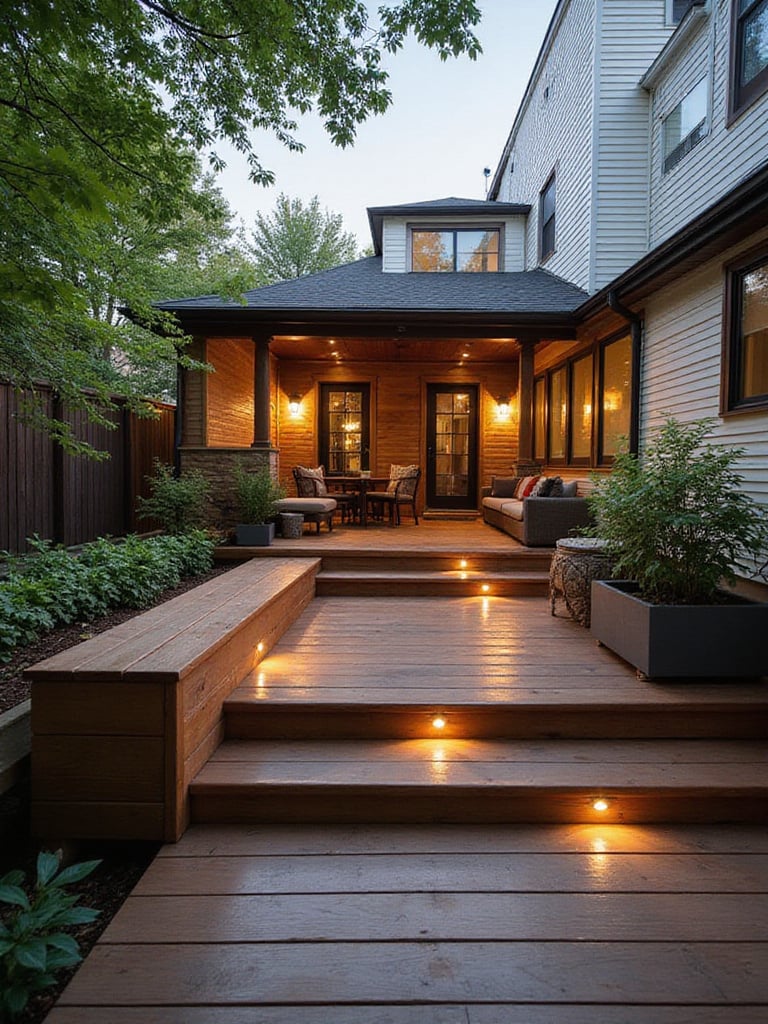
A wall-mounted vertical garden is a perfect example. You can grow a surprising amount of herbs and cascading flowers, creating a lush green wall that adds color, fragrance, and even ingredients for your cooking. Use multi-level plant stands to display a collection of terracotta pots. Look for furniture that does double duty: a bench with storage inside, or a narrow, fold-down table that attaches to the railing and can be tucked away when you’re not dining.
By layering plants, lights, and textiles vertically, you create a rich, complex space that feels like a cozy, secret oasis, no matter its size.
For those with more space to play with, you can wrap that oasis all around the house.
14. The Sun-Chaser’s Deck: Living All Around the House
A wraparound deck is the ultimate way to connect your home to the outdoors. It creates a seamless flow and allows you to live outside all day long by literally following the sun and shade around your house. Imagine having your morning coffee on the east-facing side to catch the first rays of sun, then moving to a shady, covered section on the west side for lunch, and finally gathering on the side with the best sunset view for evening drinks.
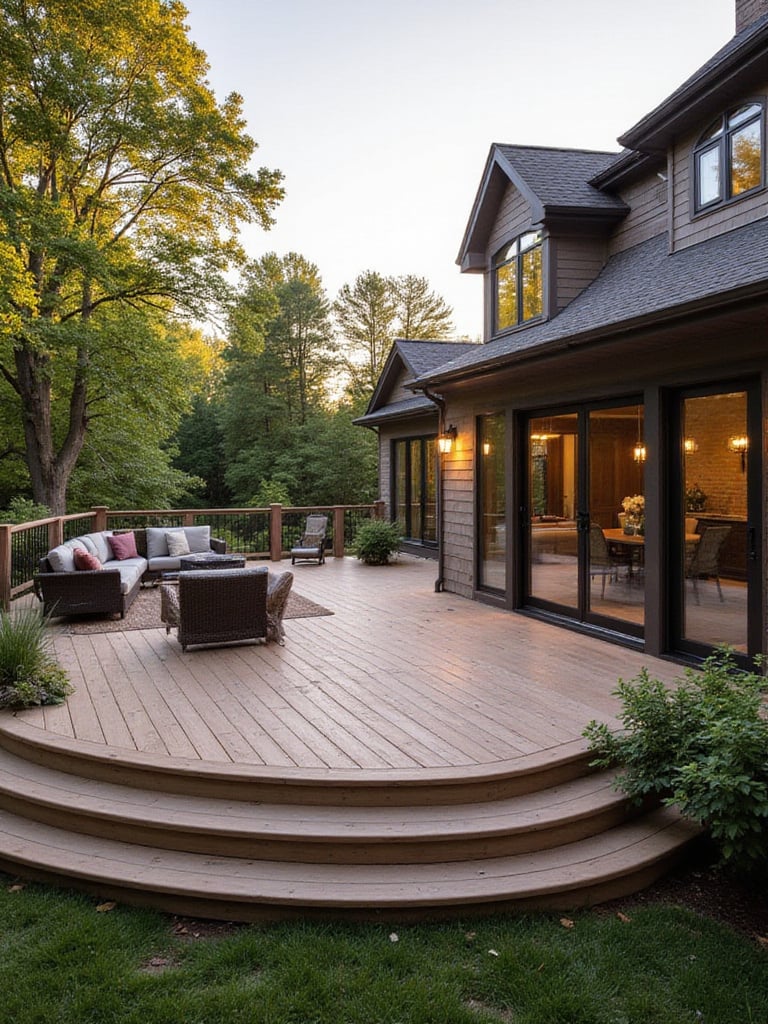
The key to a great wraparound design is to give each section its own personality while maintaining a cohesive look through consistent decking and railings. The area off the kitchen might be your dedicated grill-and-dine zone. The part off the living room could be a plush conversation area. And a quieter stretch off a bedroom could hold a pair of hammocks for napping.
It’s a design that completely changes how you interact with your home and your property, encouraging a fluid, indoor-outdoor lifestyle.
A big part of that lifestyle, of course, revolves around food.
15. The Heartbeat of the Home, Outdoors: Your Own Cocina al Aire Libre
For so many of us, the kitchen is the true heart of the home. So why not extend that heart outdoors? An outdoor kitchen, or cocina al aire libre, transforms your deck into the ultimate hub for entertaining, allowing you to cook and prepare food while staying connected to your family and guests. And this is a chance to design a space that truly reflects culinary traditions.
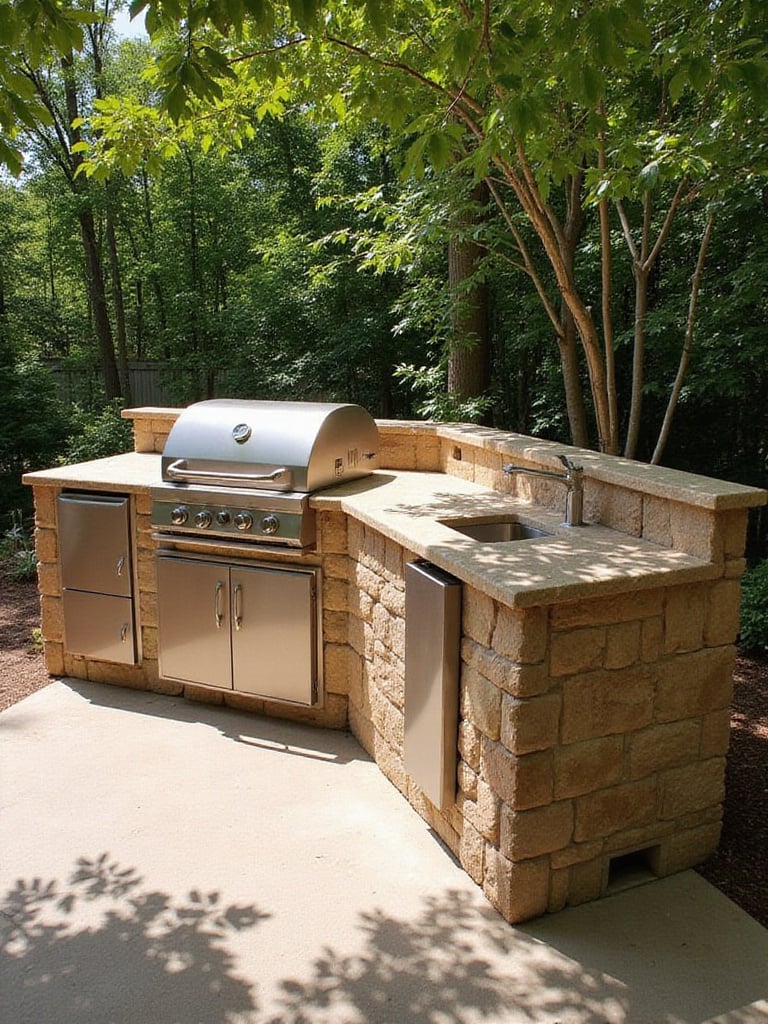
Go beyond a standalone grill. Think about a built-in countertop with a durable, easy-to-clean tile surface for chopping vegetables. Include a small sink for washing hands and produce. What really makes it special are the elements that connect to culture. I love incorporating a flat-top plancha or comal for warming tortillas and searing meats, or even a small wood-fired oven for pizzas and rustic breads. Design a long counter with bar seating on one side, so your guests can chat with you while you cook.
An outdoor kitchen turns a simple barbecue into a communal, celebratory experience.
And every good kitchen needs its own garden.
16. A Living Pantry: Weaving a Garden into Your Deck
There is nothing better than snipping fresh herbs just moments before you add them to a dish. Integrating planters and garden beds directly into your deck’s structure turns it into a living, breathing space that is both beautiful and productive. This honors the deep-rooted Latin American tradition of having edible and ornamental plants woven into the fabric of daily life.
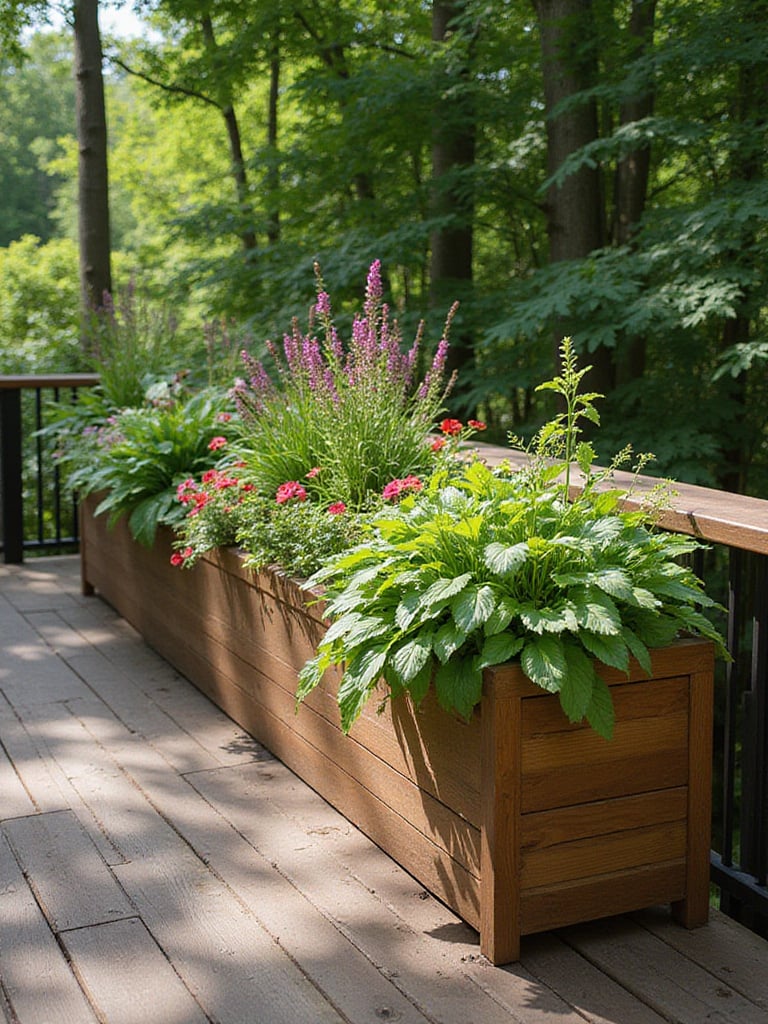
Built-in planters are a fantastic way to do this. They can be designed to double as a privacy screen, define the edge of a seating area, or create a lush backdrop for a dining table. Imagine planters overflowing with ripe tomatoes, spicy peppers, and fragrant cilantro, all just steps from your outdoor kitchen. You’re not just decorating your deck; you’re creating a living pantry that engages all the senses.
Using native plants in your design also connects your little oasis to the wider ecosystem, requiring less water and supporting local pollinators. It’s a beautiful way to honor Pachamama, Mother Earth.
While we’re honoring tradition, we don’t have to ignore the conveniences of modern life.
17. Setting the Mood: Technology that Stays in the Background
I believe technology in an outdoor space should be a gentle whisper, not a shout. It’s there to enhance the atmosphere, not dominate it. When integrated thoughtfully, modern tech can make your deck more enjoyable without taking away from the natural, handcrafted feel of the space. The key is to make it disappear.

Instead of a big, obvious TV, consider a discreet projector and screen that you can set up for special movie nights under the stars. For music, install weather-resistant speakers that are hidden within planters or under eaves. This allows the sounds of cumbia, salsa, or bossa nova to drift through the air, setting a mood without being visually intrusive. Smart lighting systems, controlled from your phone, let you effortlessly shift the ambiance from bright and festive to low and romantic as the evening goes on.
The best technology serves the human experience without becoming the focus of it.
That experience can be enjoyed for more of the year with a little climate planning.
18. Enjoying the Outdoors, Longer
Why limit deck season to just a few perfect months? With a few smart additions, you can extend your outdoor living well into the cooler days of spring and fall, creating a cozy haven that invites you out. This is all about creating comfortable “microclimates.”
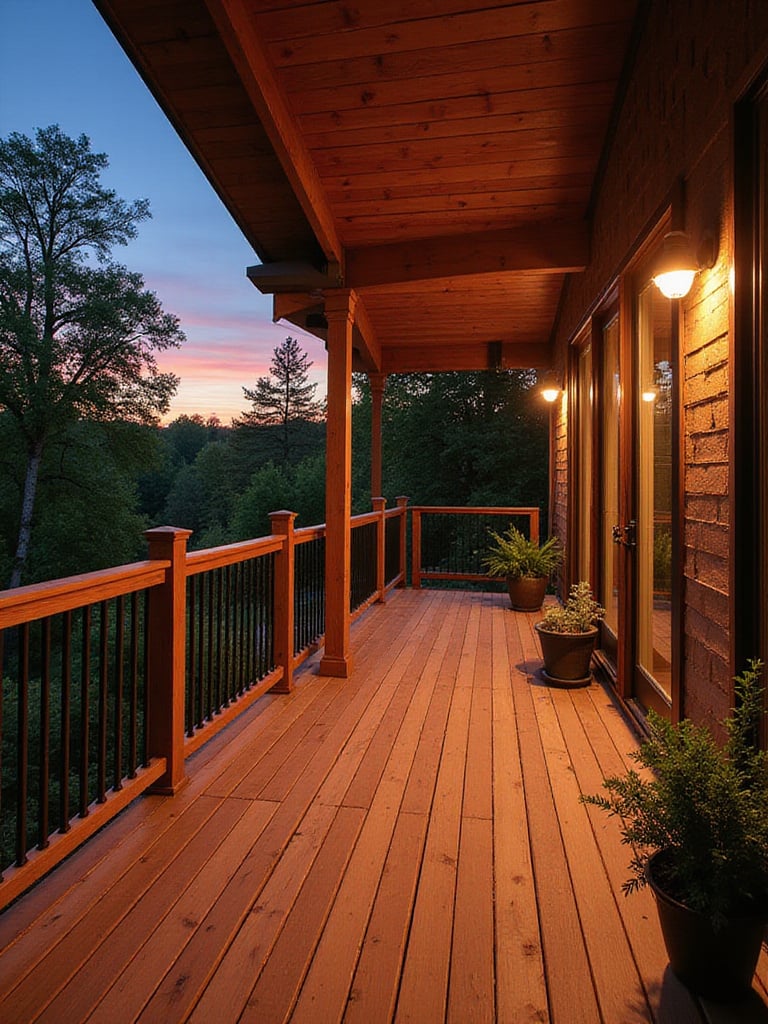
A fire feature, which we’ve talked about, is the ultimate anchor for warmth. But you can also install discreet, overhead infrared heaters in covered areas. They provide instant, direct warmth without any noise or fumes. On the flip side, for those scorching hot days, a retractable shade can provide instant relief, while a gentle misting system can lower the air temperature by several degrees, making even a hot afternoon pleasant.
These elements aren’t about fighting nature; they’re about working with it to create more opportunities for connection and enjoyment outdoors.
And sometimes, that enjoyment is found in solitude.
19. Carving Out a Space for Soul: Your Private Sanctuary
In the rush of daily life, we all need a place to catch our breath. Our decks can offer more than just social spaces; they can hold small, sacred sanctuaries for quiet reflection. This honors the contemplative side of Latin American culture, where a quiet moment in a garden or a cool corner of a courtyard is a cherished part of the day.

You don’t need a lot of space for this. It can be a simple, comfortable chair in a secluded corner, oriented to catch the morning sun. Place it near a small, bubbling fountain whose gentle sound can mask distractions and soothe the mind. Surround the space with aromatic plants like lavender or mint, which release their fragrance when you brush past them. Perhaps hang a simple wind chime that offers a soft, melodic sound.
This little nook becomes a personal retreat—a place to meditate, to read, to simply be. It’s about feeding your soul as well as your social life.
A deck that feeds the soul should also be a safe and joyful place for every member of the family.
20. A Deck for Laughter and Paws
A deck truly comes alive when it’s filled with the joyful chaos of family life. Designing with kids and pets in mind from the start ensures your beautiful space can stand up to real life, becoming a safe and beloved playground for everyone.

This doesn’t mean you have to sacrifice style for durability. Instead of sharp corners on built-in benches, opt for rounded edges. Choose a decking material with a good texture that’s non-slip for running feet (and paws!). You can even get creative and integrate a small sandbox with a lid that doubles as a bench, or paint a section of a privacy wall with chalkboard paint for endless artistic expression. For furry friends, ensuring there’s a shady spot to lie down and a designated water bowl makes all the difference.
A family-friendly deck is a durable deck, yes, but it’s also one that’s designed for memories to be made without worry.
Those memories feel even better when they are built on a foundation of respect for the earth.
21. Honor the Earth: Materials with a Story
The deep connection to nature in Latin American culture isn’t just aesthetic; it’s a form of stewardship. Choosing sustainable materials for your deck is a powerful way to honor this tradition, ensuring your personal paradise has a minimal impact on the global one. And honestly, these choices often lead to more beautiful, soulful results
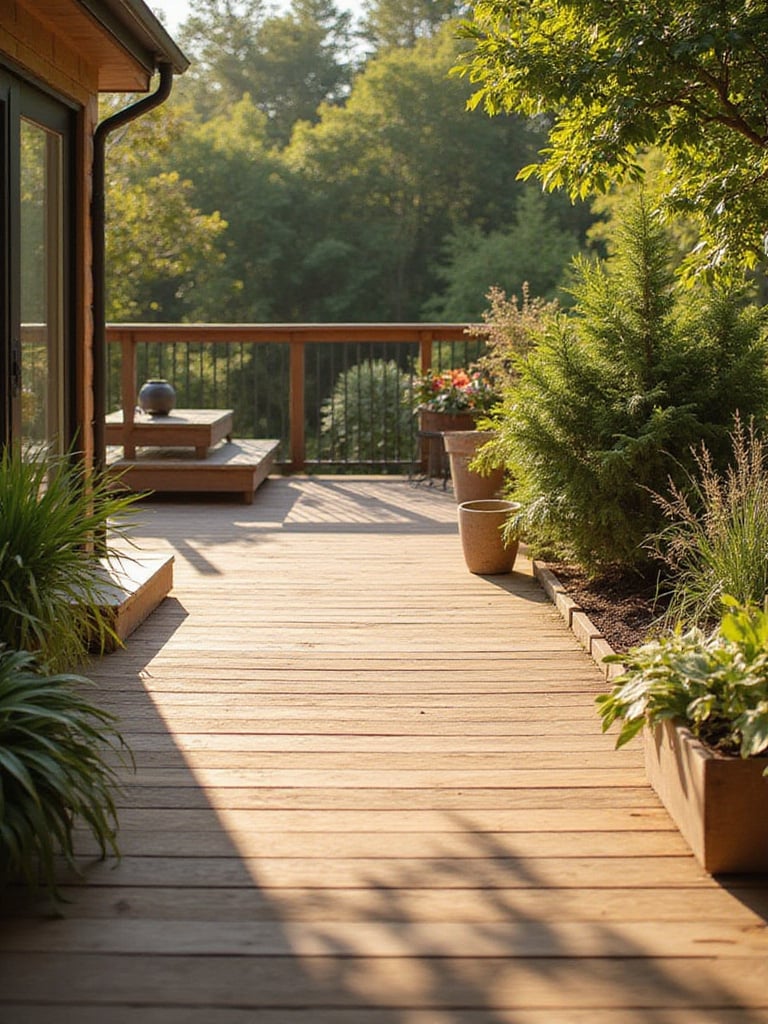
Look for wood that is FSC-certified, which guarantees it comes from a responsibly managed forest. Even better, consider using reclaimed wood. Every knot and nail hole in reclaimed timber tells a story of a past life, and it brings a depth of character and patina that new materials simply can’t match. High-quality composites made from recycled plastic and wood fibers are another great option. And when choosing stone or tile, sourcing it locally reduces the carbon footprint from transportation.
These materials don’t just look good; they feel good. They create a space that’s in harmony with your values and with the natural world.
Now for a very practical tip that maximizes your space and minimizes clutter.
22. Finding Hidden Potential: The Space Below
If you have an elevated deck, don’t forget about the valuable real estate hiding right underneath it. This often-neglected zone can be a game-changer for storage and utility, freeing up your main deck to be beautiful and uncluttered. It just takes a bit of planning to make it dry and accessible.
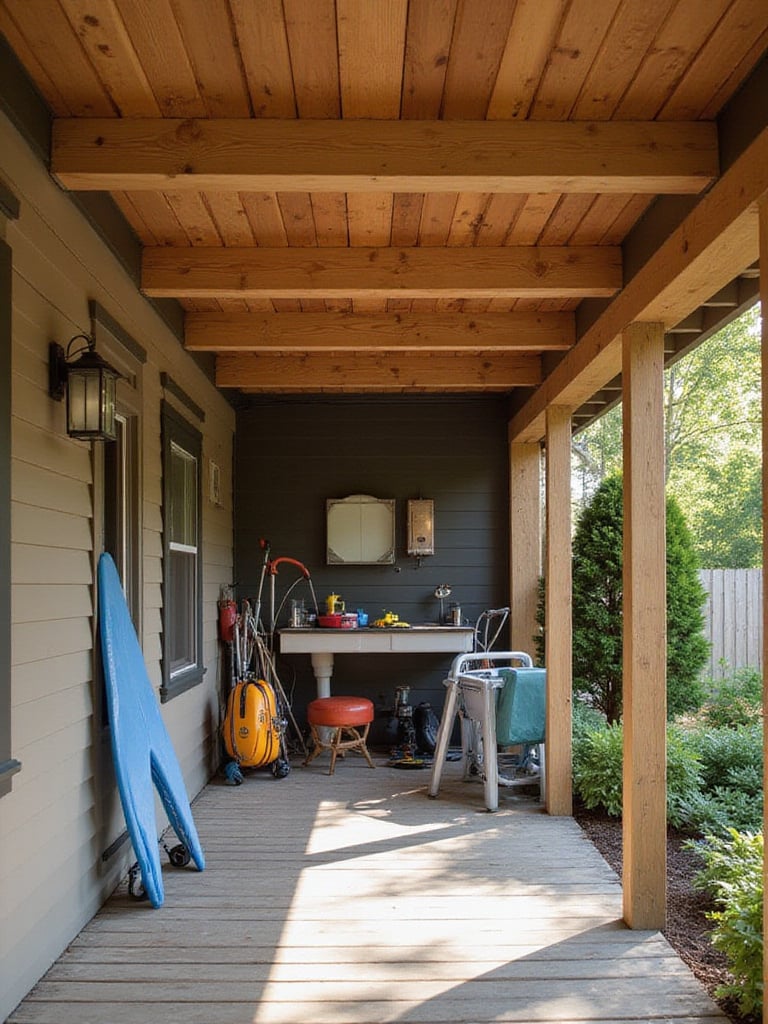
First, you’ll want to install a drainage system or under-deck ceiling to divert water away, keeping the space below dry. Once it’s protected, the possibilities are endless. It can become the perfect hidden spot to store patio furniture in the off-season, house gardening tools, or even become a rustic, shaded workshop for potting plants. By moving the purely functional items out of sight, you protect them from the elements and keep your main living area serene and spacious.
It’s one of those “insider” tips that makes a huge difference in how organized and enjoyable your outdoor space feels day-to-day.
And finally, let’s talk about putting it all together.
23. Smart Building: When Tradition Meets Modern Methods
Building a beautiful, custom deck can feel daunting. But today, there are brilliant solutions that bridge the gap between complex custom work and simple DIY kits. Prefabricated deck systems and modular components can make the process faster and more accessible, without sacrificing quality or design flexibility.
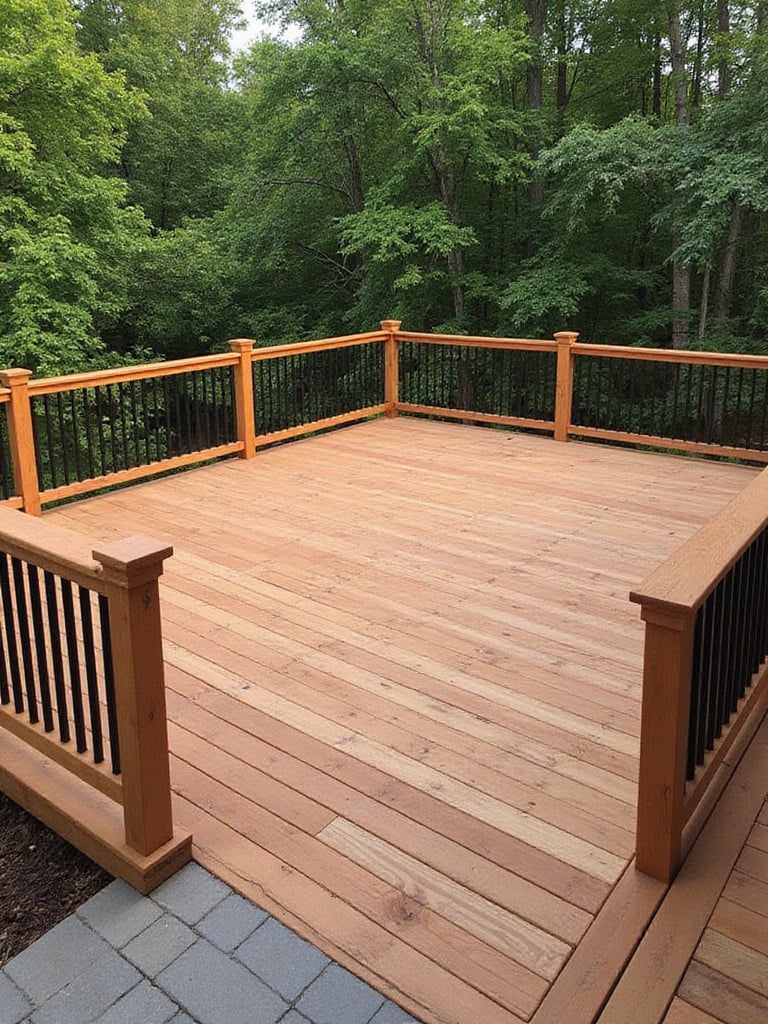
These systems are a far cry from the one-size-fits-all kits of the past. Many now offer a wide range of choices for materials, colors, and railing styles. The precision manufacturing ensures all the pieces fit together perfectly, which reduces construction time and material waste on-site. This approach can be a fantastic way to get the strong, well-built “bones” of your deck in place efficiently, freeing you up to focus your time and budget on the finishing touches that bring the personality—the hand-painted tiles, the artisan-made railings, and the beautiful plantings.
It’s a smart way to get professional-quality results while still being deeply involved in the creative process.
A Space for Your Story
As you can see, creating a deck is about so much more than lumber and screws. It’s an act of weaving together function and feeling, culture and comfort. It’s about building a space that truly reflects who you are and how you want to live. Each of these ideas is a thread you can pull on to craft an outdoor sanctuary that serves your family, honors tradition, and brings you daily joy.
The artisanal spirit that runs through Latin American design teaches us that the most beautiful things are made with intention, care, and a deep respect for both materials and community. Your deck can be a canvas for this spirit. Imagine the vibrant gatherings, the quiet moments of reflection, the taste of food fresh from your own garden, all happening in a space you created with love.
Your dream deck is waiting. The one that feels like an extension of your heart, a celebration of your heritage, and the perfect backdrop for a life beautifully lived. It’s time to begin.






